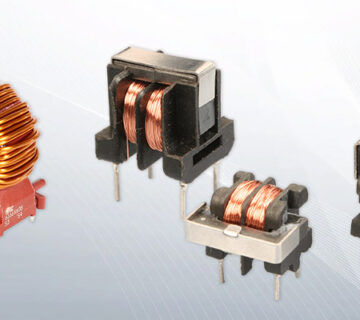Ferrite cores, which are a combination of ferrite materials like iron oxide and other metallic compounds, are used in ferrite transformers; the transformers that are suitable for a variety of applications, since they have significant advantages over other conventional transformers. Ferrite transformers are a desirable option for many applications due to the numerous benefits that they offer.
Advantages of ferrite transformers
- Compact size: Ferrite transformers are renowned for their small sizes. In comparison to other types of transformers, the high magnetic permeability of ferrite materials enables effective magnetic coupling, allowing the transformer to achieve the required voltage transformation in a smaller physical dimension. Due to its small size, the transformer can be used more effectively in applications where space is limited.
- High efficiency: Because of its low core losses and low winding resistance, ferrite transformers have a high efficiency. The ferrite core’s reduced eddy current losses and the use of premium winding materials increase overall efficiency. Greater efficiency translates into lower power loss, lower heat production, and greater energy savings.
- Good thermal stability: Ferrite transformers have strong thermal stability, which enables them to function dependably throughout a broad temperature range without suffering appreciable performance losses. The transformer core’s ferrite material has good thermal conductivity, enabling effective heat dissipation. Because of this, ferrite transformers are appropriate for applications requiring operation in challenging thermal environments.
- Operation at high frequency: Ferrite transformers are made specifically for high-frequency applications because of the special characteristics of ferrite materials, such as their high magnetic permeability and minimal eddy current losses. This makes them perfect for uses in radio-frequency (RF) circuits, switch-mode power converters, and power supply.
- Outstanding high-frequency characteristics: Excellent high-frequency properties displayed by ferrite transformers include little parasitic capacitance and electromagnetic interference (EMI). Because ferrite materials have a high magnetic permeability, the magnetic field is kept inside the core, which lowers EMI emissions. Because of the low parasitic capacitance, the high-frequency responsiveness and signal integrity are improved.
Applications of ferrite transformers
Ferrite transformers are used in a variety of fields and electronic components where high-frequency performance and small size are essential.
- Power supplies: Ferrite transformers are widely used in power supplies, particularly AC/DC converters and DC/DC converters, frequently include ferrite transformers. They are appropriate for uses like computer power supply, telecommunications equipment, and industrial power systems because they effectively transform voltage levels and manage the output voltage.
- SMP Converters: Ferrite transformers are utilized by switch-mode power converters, which are frequently found in electronic equipment, to convert voltage effectively. These converters are used in a variety of applications, including telecommunications, LED lighting, renewable energy systems, and motor drives.
- RF circuits: RF circuits, such as RF amplifiers, oscillators, and transmitters, frequently employ ferrite transformers. Because ferrite transformers’ high-frequency properties allow for exact impedance matching and impedance transformation in RF circuits, efficient power transfer and signal integrity are guaranteed.
- Telecommunications: Ferrite transformers are essential components of telecommunications equipment, including modems, routers, and telecommunication towers. They help communication systems with signal transmission, isolation, and impedance matching, providing dependable and effective data transport.
- Audio equipment: Amplifiers, mixers, and audio interfaces are just a few examples of the audio equipment that use ferrite transformers. They aid in voltage transformation, impedance matching, and signal isolation, enabling high-quality audio reproduction and effective power transfer.
Design considerations for ferrite transformers
To guarantee optimal performance, careful consideration of a number of parameters is necessary while designing ferrite transformers. For this reason, it is advisable to contact professionals that can provide flawless ferrite transformer manufacturing in India, one like Miracle Electronics, who can carry out all the below-mentioned tasks quickly and competently, and make it your investment in quality.
- Core selection: For the desired performance to be realized, the ferrite core must be carefully chosen. Core material, shape, size, and saturation characteristics are all important considerations. Based on the individual application requirements, such as the frequency range, power handling capability, and desired efficiency, the core should be chosen.
- Winding design: Performance of a ferrite transformer is significantly influenced by the winding design. For effective power transfer, minimal losses, and the necessary impedance characteristics, variables including wire gauge, turn count, and winding arrangement must be optimised. The effects of proximity, leakage inductance, and parasitic capacitance should be kept to a minimum.
- EMI considerations: Due to their built-in magnetic shielding abilities, ferrite transformers can aid in reducing electromagnetic interference (EMI). However, further steps should be taken to reduce EMI emissions and guarantee regulatory compliance, such as correct grounding, shielding, and filtering.
- Cooling and heat dissipation: Ferrite transformers can produce heat while operating, especially in high-power applications, hence cooling and heat dissipation are important. To maintain thermal stability and prevent an excessive temperature rise, the transformer design should have suitable cooling and heat dissipation devices. This may entail the application of forced air cooling, heat sinks, or cooling fans.
Ferrite transformers have several benefits, and they are used in many different industries. Engineers may create effective, dependable, and high-performance electrical systems by utilizing the advantages of ferrite transformers and using careful design techniques.




